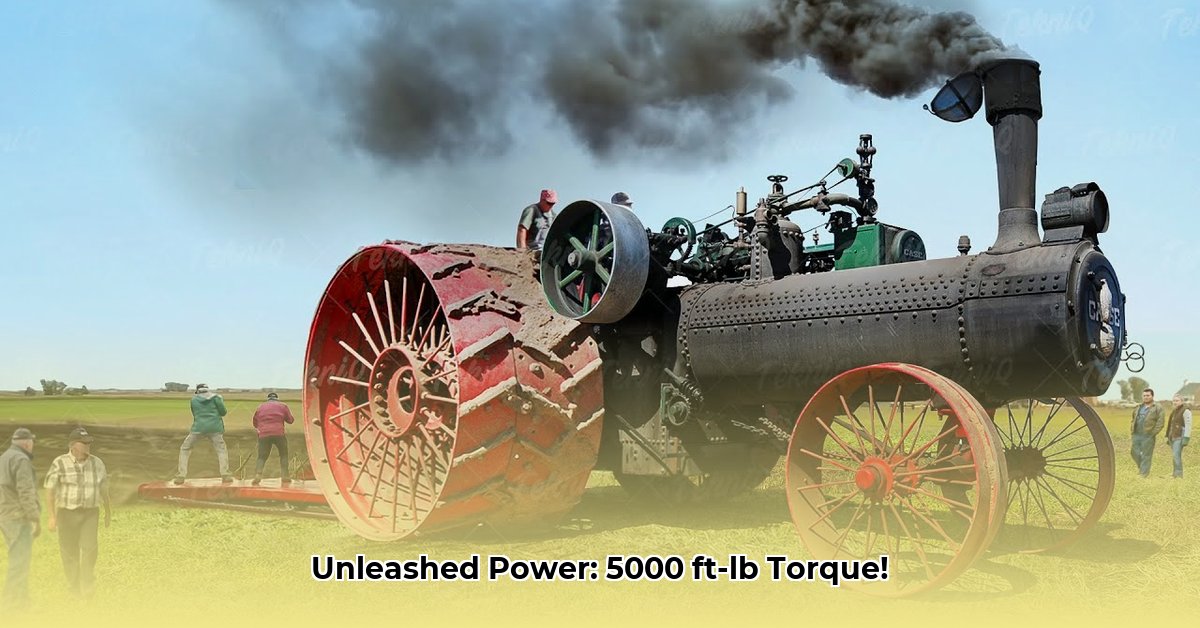
Unleashing a Giant: The Case 150's Astonishing Strength
Imagine a machine, a behemoth of iron and steam, effortlessly pulling colossal loads. That's the Case 150 steam tractor. Recent tests revealed its phenomenal strength: a staggering 4990 foot-pounds (ft-lb) of torque! This isn't just impressive; it's revolutionary for its era. The sheer power is breathtaking. But how did a team bring this engineering marvel back to life, and what does this incredible figure mean? Could this old technology still hold lessons for modern engineering? For more on Case tractors, see this useful resource.
A Labor of Love: Resurrecting a Legend
Kory Anderson and his dedicated team didn't just restore a machine; they resurrected a legend. Years of painstaking work—tracking down rare parts, meticulously crafting replacements, and painstakingly reassembling the engine—breathed new life into the iconic Case 150. This wasn't simply a mechanical project; it was a testament to human grit, ingenuity, and a deep love for engineering history. Their dedication paid off handsomely.
The Test: A Giant's Power Unleashed
The moment of truth finally arrived: putting the fully restored Case 150 to the ultimate test. Using a Prony brake (a device measuring rotational force), they measured the engine's output. The results were astonishing: 171 horsepower and a truly astounding 4990 ft-lbs of torque. While the team aimed for a slightly higher 5250 ft-lbs, the result, largely attributed to belt slippage during high-torque tests, remains extraordinary for a vintage tractor.
Didn't the belt slippage impact their goals? How could that be overcome in future tests?
Taming the Beast: Overcoming Challenges
While the sheer power was undeniably impressive, the team faced significant hurdles. The considerable belt slippage at high torque presented a major challenge, highlighting the need for future improvements to the power transmission system. Could stronger belts or a redesigned pulley system solve this? The possibilities for optimization are exciting. It's like taming a wild bronco—immense power needs careful control.
Beyond the Machine: A Community Effort
This remarkable restoration wasn't a solo effort. A passionate community of steam engine enthusiasts rallied around the project, their collective energy fueling its success. The Case 150's appearance at the Western Minnesota Steam Threshers Reunion further underlined this widespread passion. It's more than just a tractor—it represents dedication, teamwork, and a shared connection to history.
The Future is Steam: Ongoing Investigations
What's next for this incredible machine? Further testing and analysis are planned to fully understand its capabilities. Potential improvements to the belt system are on the table, and perhaps exploring alternative power transmission methods. This isn't just about fixing a problem; it's about pushing the boundaries of what's possible with vintage technology. There’s a wealth of knowledge hidden within these historical powerhouses that we’re only beginning to uncover.
How to Improve Belt Performance on a Large Steam Engine
Key Takeaways:
- The Case 150 steam tractor boasts incredible torque, exceeding 4990 lb-ft.
- Its impressive power, around 170 hp, showcases exceptional engineering.
- Prony brake testing—while useful—limits accurate peak power measurement due to belt slippage. More precise dynamometer technology is needed.
- The Case 150's restoration and testing provide valuable data for steam engine enthusiasts and researchers.
The Case 150—a behemoth resurrected from historical blueprints—isn't just any tractor; it's a steam-powered giant generating astonishing torque. Initial testing hit figures exceeding 4990 lb-ft! That's raw power. But during testing, significant belt slippage occurred—a critical issue. Let's delve into how to improve belt performance on a large steam engine.
Understanding the Powerhouse
The Case 150's approximately 170 hp is impressive, but the Prony brake presented limitations. It accurately measures torque at lower loads, but at higher levels, belt slippage became a major factor, hindering accurate horsepower measurements.
The Prony Brake's Limitations
The Prony brake, while effective, wasn't designed for this engine's power. As the team pushed the Case 150's limits, slippage resulted in a slightly lower recorded torque than the target. This highlights the need for more advanced testing equipment.
Strategies for Enhanced Belt Performance
Improving belt performance requires addressing several factors:
- Belt Material & Condition: Regularly inspect belts for wear, cracks, and fraying. Upgrade to a stronger material if needed.
- Belt Tension: Proper tension is crucial. Too loose causes slippage; too tight leads to excessive wear. Careful adjustment is key.
- Pulley Alignment: Misaligned pulleys cause uneven wear and slippage. Ensure precise alignment.
- Lubrication: Appropriate lubrication reduces friction and wear. Use a lubricant suited to the belt material and operating conditions.
Next Steps: Refining the Process
The Case 150 project necessitates more sophisticated testing. While the Prony brake offers valuable data, upgrading to a modern dynamometer is crucial for accurate measurements. This will provide more accurate data and help refine our understanding of how to improve belt performance.